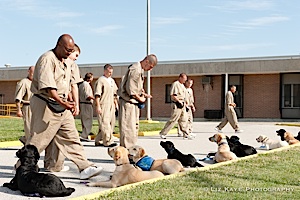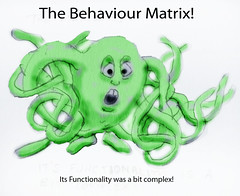Reward based training methods are slowly gaining in popularity among dog professionals including: trainers, veterinarians and behaviorists. But popular beliefs about the value of punishing for so-called ‘bad’ behaviors still run strong. In a society where we justify scolding, handing out speeding tickets or putting people in prison when humans misbehave, it’s no wonder that punishment is still the most logical way to deal with Fido’s behavior problems. Whether we agree with it or not, more studies are pointing to the negative and sometimes tragic effect of using punishment and its impact on our dog’s welfare. The effect of using coercive methods may have other unsuspected consequences: it may also impact the person inflicting the punishment. It’s likely that how we interpret our dog’s behavior directly affects how we think and feel about him, but also, how we relate to other people.
 Among owners, some of the popular ways to punish a dog for undesirable behavior are: hitting or kicking the dog (43%), growling at the dog (41%), physically forcing a dog to let go of an object (43%), alpha rolling (41%) and staring the dog down (39%)(Herron & al. 2008). These statistics were collected amongst owners who were answering a survey as they were making an appointment with a behavior professional. In most cases, the owners were complaining about more than one behavior problem with their pet, most of which could be attributed to different manifestations of fear and anxiety. Among the most common were aggression to unfamiliar people (48%), aggression to familiar people (43%), aggression to dogs (40%) and separation anxiety (32%). Most owners tried to deal with the problems themselves, relying on their own source of information, and were consulting a professional as a last resort. Unfortunately, as the study shows, their attempts at resolving the behavior issues may have in fact largely contributed to the problem.
Among owners, some of the popular ways to punish a dog for undesirable behavior are: hitting or kicking the dog (43%), growling at the dog (41%), physically forcing a dog to let go of an object (43%), alpha rolling (41%) and staring the dog down (39%)(Herron & al. 2008). These statistics were collected amongst owners who were answering a survey as they were making an appointment with a behavior professional. In most cases, the owners were complaining about more than one behavior problem with their pet, most of which could be attributed to different manifestations of fear and anxiety. Among the most common were aggression to unfamiliar people (48%), aggression to familiar people (43%), aggression to dogs (40%) and separation anxiety (32%). Most owners tried to deal with the problems themselves, relying on their own source of information, and were consulting a professional as a last resort. Unfortunately, as the study shows, their attempts at resolving the behavior issues may have in fact largely contributed to the problem.
I’m really in no position to judge how owners chose to deal with these issues as I have once been in their shoes so I know how difficult it can be. As we say, you don’t know what you don’t know. So when the dog growls or misbehaves, based on cultural belief, the most logical response is to make sure the dog doesn’t have the upper hand and ‘show him who’s boss!’ After all, that idea is still strongly supported in many books, TV shows and even among training professionals. So naturally, without knowledgeable guidance, many owners resort to the use of punitive methods.
Today, the alpha wolf myth has been replaced by a more realistic way to understand our dog’s emotional reactions. Many behaviors once considered an expression of dominance are now recognized as attempts by the dogs to put more distance between themselves and what they feel threatened by. Barking, growling and even biting are mostly expressions of fear, whether fear of getting something they value taken away from them (like in the case of resource guarding) or fear for their own safety. So naturally, the tragic result of punishing such displays often increases the problem rather than solve it. Now the dog’s fear has just been confirmed. His owner did forcefully take away what he valued or did indeed give him a hard time. Sadly, the relationship between owner and dog has been damaged. The care and love that once existed between human and animal has been tainted or replaced by fear, confrontation and misunderstanding.
Punishing the dog, doesn’t only affect the animal, it also has an impact on the person who administers the correction. I spent many years teaching basics of dog behavior and clicker training techniques to men and women in prison. Every one of them came with a strong belief that ‘bad’ behavior had to be punished. Ignoring or treating some of the ‘spiteful’ displays of the dogs, was a clear sign of weakness of the handler.
Interestingly, in one of the prisons, there was already another dog program that taught alpha rolls and leash corrections to their handlers, so the two philosophies co-existed within less than 50 ft of one another. The handlers in my group were required to talk in a normal or high pitch happy tone of voice, while acting as Pez dispensers, delivering treats to the pups on a regular basis. The others were barking out commands and leash popping the dogs. In a prison environment, this equates to one group acting like ‘sissies’ and the other like ‘real men’! Dog training is not just about training dogs, it’s also about building an identity and a way to relate to other beings. The trainers can feel in charge, strong, expert or compassionate, knowledgeable and understanding. Both groups were out working with the dogs at the same time and would constantly watch one another. I can’t tell you how hard this was at first for the handlers in my group, as they were constantly being mocked by other inmate,s but also from some of the correctional officers.
As months went by, the handlers in my group were visibly softening in their ways, gaining in patience and understanding. The group dynamics were changing from competitive to more open and helpful. As they gained insight into the dog’s mind, recognizing how much stress and anxiety dogs can experience, they also learned more about their own reactions to others and were more aware of their own fears. Most importantly, they learned how their actions would impact not only the dog but also others around them. Of course, not every handler was as receptive and open to change. Just like in dogs, habits can be very resistant and the longer they’re practiced, the harder it is to get rid of them. After a year in the facility, many handlers from the other group started asking questions. Seeing the results of reward based training on the dogs, their disbelief slowly changed into interest and desire to learn. Once ridiculed, the handlers in my group were now teachers to the other group and recognized by many as experts in dog training and behavior modification. Change was happening!
Over the years, I have witnessed many times the influence of knowledge and understanding of dog behavior on the people who work with them. I’m not aware of any study on the subject, but we know that our perspective determines how we react to particular situations. When we view the dog as ‘mean’ or ‘spiteful’, we feel frustrated or angry and build resentment along with the need to show him otherwise. Dropping the dog at the local shelter then becomes easier as those feelings develop. When we see fear and anxiety in our dog’s behavior, we feel compassionate and our need for caring and helping takes over. Similarly, we get desensitized to punishment and are gradually able to inflict stronger and harder levels of discomfort when we don’t get results. In doing so, we also build stronger habits of behavior and may also be more likely to adopt stronger stances towards other people. Dogs and humans are similar in many ways and just as we strive to see the dog’s behavior for what it is through scientific advances, we also need to recognize that humans are not much different. Understanding the underlying dynamics of human behavior can also help us develop more compassion and tolerance for those with different perspectives on dog training.
Most owners adopt a dog with the desire to develop a loving and fulfilling relationship with the animal. When reality hits however, and the cute puppy destroys the new carpet, their knowledge and understating of the behavior will often determine the fate of the relationship. Confrontational techniques have been shown to increase the problems, sometimes to the point where the owners don’t think they have any other choice but to relinquished the dog to the pound (Hiby & al., 2004). The most effective way to truly affect change and to help dogs as a whole, is by educating and leading by example while understanding versus condemning those who still think differently.
Jennifer Cattet Ph.D.
Related articles
http://avsabonline.org/resources/position-statements










I’m a cross-over trainer and I used to use a choke collar on my aggressive dog 25 years ago. Thankfully, I learned (the hard way – a bite) that punishment was making my dog worse. I lucked into a clicker training class and the rest is history! I will forever be thankful to that dog; he lived to the ripe old age of 15 because clicker training saved his life.
Really interesting statistics. I enjoyed reading your post. I’m trying to spend more time with my dog and reward her. It can be challenging at times, but in the end it will be completely worth it 🙂
Great post! Like Laurie, I’m also a cross-over trainer. I remember blaming so much of my dog’s behavior on *her*, rather than on her lack of training. I’m so glad that I found clicker training – I was able to turn all of her unwanted behaviors around and have a lot of fun teaching her new things that I previously thought were impossible.
Great post! I too am a cross over trainer. I have a 4 yr old Rottie we do obedience together a perfect dog in everyway with one exception KIDS… I don’t have little children around us and we live in the Pacific Northwest so during rainy season not too many kids are out playing we did the Pet smart/Home Depot etc. He is a very kind and gentle soul a great worker and a wonderful companion. Recently his obsession over took him at a show we were ready to go into the ring when a childs voice happened, I had great focus but instantly lost it as he was singing and twisting I tried to get him turned the oposite direction a lady with a baby in her arms was standing 5′ from us then a man with a child in a stroller was coming our way. He gets overly stimulated, singing and dancing no control I had to excuse us and take him out of that situation. I left the entry of the ring I have to say mad at him but quickly realized I was mad at myself for not training this (proofing) more and my lack of knowledge in being able to help him was over whelming. My mission is to make him comfortable with all sizes of humans and to educate myself more in how to do that… I am so glad I didn’t force him to deal with it and am so happy I took him away and put him in his crate.
Fabulous blog post.
Absolutely wonderful article. Thank you! I work in a prison training program using R+ force-free methods. Some of our handlers have come from other prisons where they were taught punishment based training – it’s a tough transition. As a cross-over trainer myself, I know where they are coming from. But what a wonderful transformation to watch. THANK YOU!
This article looks at why punishment may be so appealing http://www.yourpitbullandyou.com/the-carrot-or-the-stick-2/
I know that ‘crossing-over’ made a big difference in my life. I loved my dogs but used to get so tense afer a training session — so much so that I was often reluctant to ‘train’.
When I adopted reward-based methods I discivered joy in actually working with my dogs — no longer worrying that the glass was half-empty, but joy of knowing that the glass was half-full 🙂
Really, dogs are like kids. They are all unique and really just want to please. They all have fears and issues, and it is up to us, as their owners to learn how to help each of them be settled and happy. Great article – thanks.
Great post! It would be very interesting to do a study of +P based and +R based trainers to see if and how they interact differently with people in general.